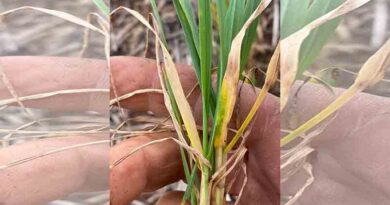Northern growers warned to consider elevated disease risk when making chickpea planting decisions
14 April 2022, AU: While ongoing wet conditions have boosted winter cropping prospects for parts of the northern region, flood water and a flourishing green bridge have increased chickpea disease risk, even in paddocks that have historically been clean.
NSW Department of Primary Industries (DPI) Research Officer, Sean Bithell, said there was a risk that Phytophthora root rot would be widespread across the northern region this season, with ongoing rain providing ideal conditions for the disease and volunteer crops supplying an alternate host for the pathogens over summer.
Similarly, NSW DPI Field Pathologist, Hayley Wilson, said widespread ascochyta blight infections were recorded last year and volunteer chickpeas pose a greater risk of disease carryover than previous years into the coming season.
Also Read: Good season for kiwiberries despite challenges
“This year we’re expecting a lot of chickpea disease in paddocks due to the wet conditions supporting high pathogen inoculum production last year,” Mr Bithell said.
“Paddocks that haven’t historically been impacted by phytophthora are at a higher risk than normal, as run-off from rain and flood waters could have transported inoculum into clean country.”
Grains Research and Development Corporation (GRDC) Crop Protection Manager North, Vicki Green, said while she acknowledges growers could be deterred from planting chickpeas this season due to the elevated disease risk, applying integrated management strategies could help mitigate the risk.
“The benefits of having a pulse in your crop rotation still hold true – they’re a good break crop for cereal disease and don’t require nitrogen,” she said.
“This could make them an attractive option to growers considering the historically high fertiliser prices this season.”
Mrs Green said GRDC has invested in numerous projects to develop integrated management strategies growers can adopt to mitigate chickpea disease risk. This includes pre breeding work to develop more disease resistant varieties.
Both Mr Bithell and Miss Wilson said variety selection would be an important management tool for growers going into a wet season, especially considering the risk of phytophthora and ascochyta is hard to identify in paddocks prior to sowing.
“A lot of work goes into breeding varieties with improved disease resistance and then evaluating these varieties’ performance in the National Variety Trials,” Miss Wilson said.
“Growers are encouraged to use the disease ratings generated in that research when selecting varieties, especially in a high disease risk year.”
As part of the GRDC and NSW DPI five year Grains Agronomy and Pathology Partnership (GAPP), Miss Wilson conducted research on the effectiveness of fungicide sprays to control ascochyta infection.
“Trials showed a preventative spray before the first rainfall event after sowing and monitoring crops for infection before any rainfall events after that will be the most effective control method you have, so growers should be considering what chemicals they have available to them now,” she said.
“Our research has shown that best results are achieved by using preventative fungicides early and limiting the development of the disease in the crop. While there are some newer fungicides registered for ascochyta control after rainfall [infection] events, prevention is always better at reducing impact to yield than chasing the disease once it is widespread in a crop.
Mr Bithell said it was extremely difficult to control phytophthora once it impacts a crop, so it’s important growers assess their paddock history and avoid planting in low lying areas that are susceptible to waterlogging.
Mr Bithell has conducted research as part of the GAPP that has shown that a metalaxyl seed treatment could be used as a tool to minimise yield loss from phytophthora in varieties with improved resistance. However, if a variety is highly susceptible, a seed treatment is not sufficient to reduce the impact of the disease. You can watch his presentation regarding this research via the GRDC website.
You can also view Miss Wilson’s presentation on ascochyta management via the GRDC website.
Mrs Green said GRDC would continue to invest in research, development, and extension to further maximise chickpea yield potential in the north.
“It’s so important we continue to fund this research to assist growers in making more informed management decisions that improve their bottom lines,” she said.
Growers can access The Chickpea Disease Management Guide to assist with identifying and addressing disease in pulse crops.















